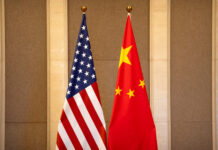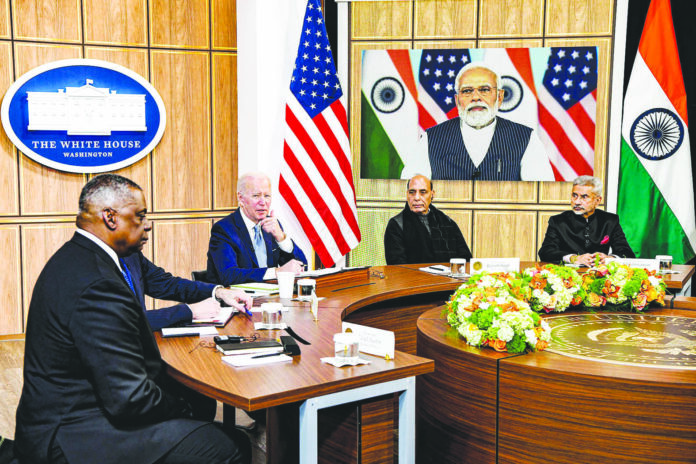The increasing defence cooperation between India and the US, coupled with two decades of strategic partnership, has significant implications for South Asian regional stability. One of the key aspects of the Indo-US strategic partnership is the collaboration in the military application of emerging technologies (ETs). ETs include artificial intelligence, advanced sensor development, unmanned systems, quantum physics and undersea domain awareness.
On the eve of state visit of the Indian Prime Minister to the US in June 2023, a senior US Defense Department official said, “this is a transformational moment in the US-India defence partnership. To have the world’s largest democracies working more closely together on strategic technologies can leverage for security and it is a natural next step in this relationship.”
He further maintained that “we now have working groups on everything ranging from cyberspace and critical technologies to maritime security, and India is leading in those forums together with the US and like-minded partners.”
From a view point of great power competition, the US has developed unwarranted defense cooperation with India to counter China’s growing influence, without consideration of regional security dynamics of South Asia. The policymaking circles in the US consider India as a potential counterweight to China, an idea that is often considered to be underappreciated.
In the recent times, the South Asian region has witnessed significant geopolitical shifts as great powers compete for influence and strategic advantage. The US and India have sought to deepen their defence and technological ties through diverse range of security initiatives. These initiatives include the Initiative for Critical and Emerging Technologies (iCET), the Defense Technology and Trade Initiative (DTTI), the Major Defense Partner (MDP) status, Logistics Exchange Memorandum of Agreement (LEMOA), Communications Compatibility and Security Agreement (COMCASA), as well as the Defense Trade and Technology Initiative (DTTI).
In June 2023, the theme of “Powering a Next Generation Defense Partnership” during Modi’s visit to the United States resulted in three major deals. These included MoU between General Electric (GE) and Hindustan Aeronautics Limited (HAL) for manufacturing GE F-414 jet engines in India for the HAL Light Combat Aircraft Mk 2; a substantial USD 3 billion deal was announced for India to acquire General Atomics MQ-9B High Altitude Long Endurance (HALE) unmanned aerial vehicles (UAVs), to be assembled in India; and the India-US Defense Acceleration Ecosystem (INDUS-X) was unveiled, aiming to foster joint defence technology innovation and co-production between the two countries industries.
In the domain of space, the National Aeronautics and Space Administration (NASA) and the Indian Space Research Organization (ISRO) were jointly developing a strategic framework for human spaceflight cooperation by the end of 2023. Under this strategic framework, NASA had to provide advanced training to Indian astronauts at the Johnson Space Center in Houston, Texas, with a goal of mounting a joint effort to the International Space Station in 2024. Recently, India also joined the US-led Artemis Accords, through which the US hopes to explore the moon and beyond.
During Modi’s state visit to the US last year, an MoU was signed on the Semiconductor Supply Chain and Innovation Partnership. Under this agreement, Micron Technology Inc. committed to investing up to USD 825 million to establish a new semiconductor assembly and test facility in India. As noted in an article by Syed Mohammad Ali publish by the Stimson Center, “While the primary purpose of Indo-US defence deals is countering China, they also carry implications for Pakistan’s national security.”
The increasing defence collaboration between India and the US in ETs aim to help former achieve technological advancement in military and are centered around competing with China. However, the indirect implications for Pakistan cannot be overlooked. The US-India uneven alignment and their defence cooperation could illuminate Pakistan’s security by deepening its apprehensions about strategic encirclement. Conversely, Pakistan may be compelled to bolster its own military capabilities in the field of ETs, leading to an unprecedented arms race in nuclearized South Asia. Such an escalation could have severe ramifications for regional stability and pose a significant challenge to international non-proliferation efforts.
As a responsible military power, Pakistan has formally communicated its concerns to the US regarding the increasing level of defence collaboration between the US and India, asserting that such cooperation poses a direct threat to Pakistan’s security interests. It is pertinent that the recently concluded Indo-US defence deals could have implications for Pakistan’s diplomatic relations with the US. As noted by Michael Kugelman, Director of the Wilson Center’s South Asian Institute that “as India becomes a key strategic partner of the US, Pakistan may perceive a shift in favour of India.” Historically, the US has played a crucial role in shaping South Asia’s geopolitics through conflict mediation, peace processes, and economic/military aid. Countering the heightening defense collaboration along with power balancing will be critical for Pakistan’s policymakers to maintain stability in the region.
It is pertinent to highlight that the Indo-US technological cooperation could create India’s asymmetric advantage over Pakistan in regional forums and diplomatic circles. Moreover, India’s enhanced technological prowess may enable it to exert greater influence in international arenas, possibly marginalizing Pakistan’s voice on key regional and global issues.
Lastly, the acquisition of ETs in military by India may lead to concerns over military imbalances, creating serious security challenges for Pakistan. To prevent potential destabilization in a region which is already prone to territorial conflicts, all great powers should adopt a responsible and cautious approach, focusing on constructive engagement, dialogue and the pursuit of shared interests to maintaining stability in the region.






















